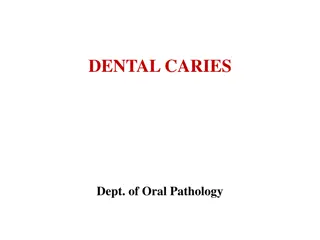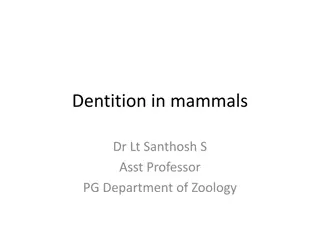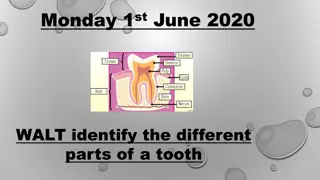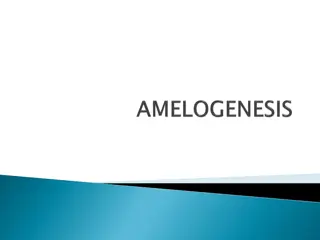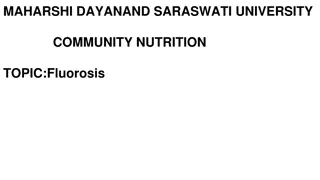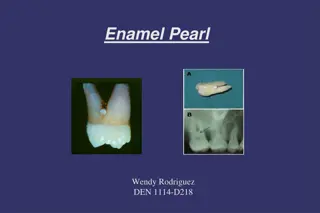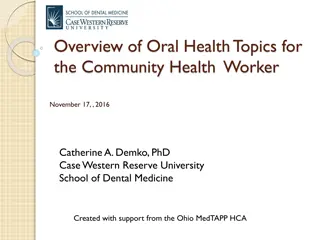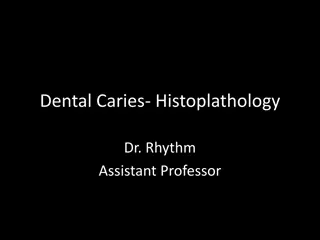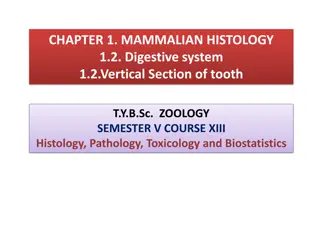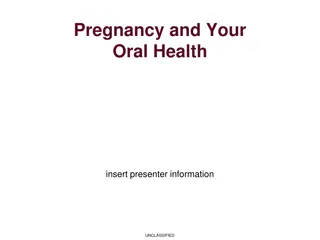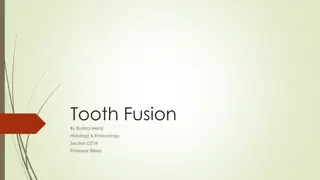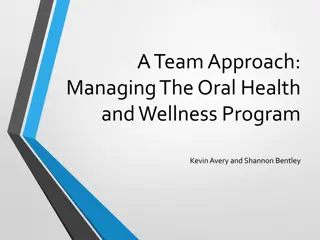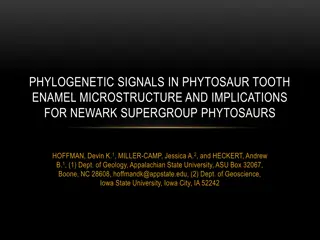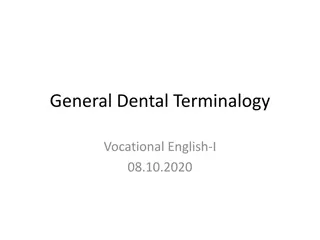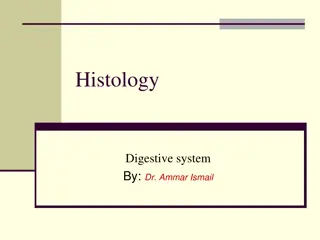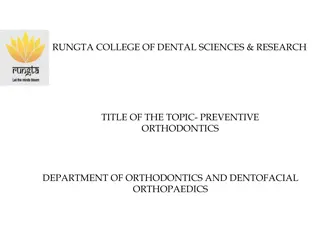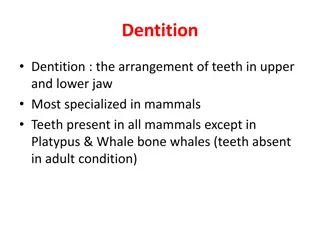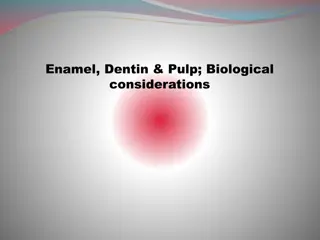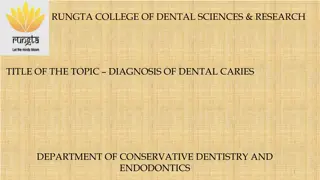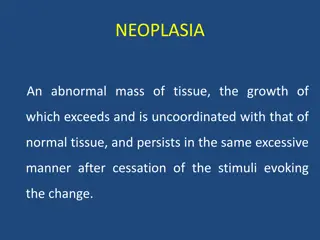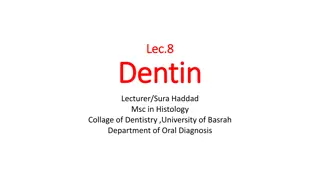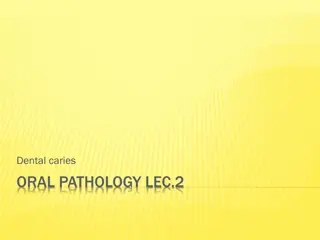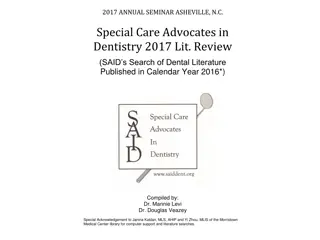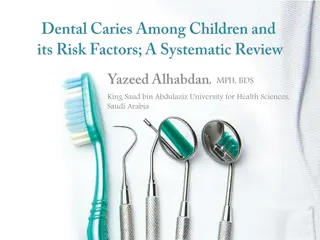Sai Manglam Manav Seva Dental Clinic
\ud83e\uddb7 Your trusted partner in dental care! Sai Mangalam Manavseva Dental Clinic - where skilled professionals provide expert assistance for all your oral health needs. \ud83c\udf1f From basic to laser and surgical dentistry, we've got you covered. Our specialists excel in procedures like vest
3 views • 1 slides
ENAMEL
Enamel, the hardest calcified tissue in the human body, forms a protective covering over the teeth, adapting them for mastication. Its thickness varies across different surfaces of the teeth, with maximum thickness found on cusps. The structure of enamel makes it brittle, especially when it loses su
2 views • 46 slides
Understanding the Development of Occlusion and Dentition
Exploring the stages of tooth development, eruption, theories, and keys to normal occlusion. Learn about primary and permanent dentition, dental formulae, dental lamina, odontogenic cells, and enamel organ formation in the process of tooth development.
6 views • 108 slides
DEVELOPMENTAL STAGES
The developmental history of a tooth is segmented into distinct stages, namely the bud, cap, and bell stages. Each stage represents critical morphological changes in tooth development, from the initial formation of tooth buds to the differentiation of enamel organs and dental papilla. Understanding
6 views • 33 slides
Understanding Enamel Caries: Zones and Histopathology
Enamel caries is examined through histopathology, revealing four distinct zones - Translucent, Dark, Body, and Unaffected. Each zone presents unique characteristics, such as pore formation and light absorption. Understanding these zones is crucial for identifying and describing enamel caries accurat
0 views • 16 slides
Mammalian Dentition and Tooth Structure Exploration
Understanding dentition in mammals sheds light on their evolution, classification, age approximation, and dietary habits. The arrangement of teeth, tooth structure, development, and types of mammalian teeth are discussed, highlighting unique features like thecodont attachment, enamel coating, and de
2 views • 16 slides
Dental Developmental Stages: Bud, Cap, and Bell Stages Explained
The developmental history of a tooth is intriguingly divided into distinct morphologic stages - the bud, cap, and bell stages. Each stage represents a crucial phase in tooth development, from the initial formation of tooth buds to the intricate differentiation of enamel organs and dental papilla. Un
1 views • 40 slides
Formation of Hertwig's Epithelial Root Sheath in Tooth Development
The formation of Hertwig's Epithelial Root Sheath (HERS) is crucial in determining the shape, length, and number of roots in teeth. It initiates the formation of radicular dentin, marking the beginning of root development after enamel and dentin formation. HERS consists of outer and inner enamel epi
0 views • 29 slides
Understanding the Different Parts of a Tooth
Explore the structure of a tooth by learning about its various parts such as enamel, dentine, pulp, and more. Discover the difference between the crown and root, and engage in interactive activities like labeling diagrams and creating models to enhance your understanding. Watch a video for a detaile
0 views • 7 slides
Pediatric Dental Crown and Root Fractures Management Guidelines
Guidelines for managing pediatric dental crown and root fractures are provided based on the type and severity of the fracture, along with treatment recommendations, follow-up schedules, and parent/patient education tips. The content covers uncomplicated crown fracture, primary tooth enamel-dentine f
2 views • 9 slides
Development Stages of Inner Enamel Epithelium
The life span of cells in the inner enamel epithelium can be divided into six stages: Morphogenic, Organizing, Formative, Maturative, Protective, and Desmolytic. Differentiation of ameloblasts occurs in various regions of the tooth germ. Amelogenesis, the enamel formation, takes place during the for
0 views • 48 slides
Key Insights on Preventive Adhesive Restoration in Dentistry
This article covers the concept of preventive adhesive restoration (PAR) in dentistry, involving techniques like visual examination, laser fluorescence, and radiographs for diagnosing caries. It discusses early interventions such as balancing oral environment, plaque cleaning, and remineralization,
1 views • 20 slides
Overview of Preventive Adhesive Restoration in Dental Care
Preventive adhesive restoration in dentistry involves using adhesive materials like preventive resin to restore teeth. Techniques for diagnosing caries include visual examination, translumination, laser fluorescence, and radiographs. Early interventions focus on balancing oral health, cleaning plaqu
3 views • 20 slides
Root Development in Tooth Growth Process
Root formation plays a crucial role in the development of teeth, starting after enamel and dentin formation at the cementoenamel junction. Hertwig's epithelial root sheath (HERS) molds the shape of roots, initiating radicular dentin formation. The cervical loop forms an epithelial diaphragm, narrowi
0 views • 23 slides
Understanding Fluorosis: A Critical Health Concern in Endemic Regions
Fluorosis, a prevalent condition in parts of India, China, Tanzania, and South Africa, affects millions due to high fluoride levels in drinking water. It manifests as dental and skeletal fluorosis, causing various symptoms based on exposure levels. Dental fluorosis leads to enamel discoloration and
0 views • 10 slides
Understanding the Relationship Between Diet and Dental Caries
Dental caries is a common chronic disease affecting all age groups, characterized by demineralization of tooth tissues due to microbial activity. Carbohydrates in the diet play a crucial role in caries development. Evidence shows a clear link between diet and caries incidence through various studies
0 views • 34 slides
Understanding the Impact of Nutrition on Periodontal Disease
Periodontal disease, like caries, is multifactorial and influenced by the balance between bacterial challenge and host defense. Nutritional factors play a subtle but significant role in maintaining periodontal health. A deficiency in nutrients can adversely affect the periodontal tissues and modify
0 views • 23 slides
Understanding Enamel Pearl Anomaly in Dentistry
Enamel Pearl is a developmental anomaly where small nodules of enamel form below the cemento enamel junction, mainly on permanent teeth. This anomaly, detected radiographically, can lead to bacterial accumulation, periodontal issues, and inflammation if left untreated. Dental hygienists play a cruci
0 views • 8 slides
Importance of Oral Health for Community Health Workers
Oral health is crucial for overall well-being, impacting aspects from chewing to psychosocial health. Untreated oral diseases like dental caries and gum disease are prevalent, underscoring the significance of early detection and prevention. Community Health Workers play a vital role in raising aware
0 views • 27 slides
Understanding Dental Caries: Causes and Prevention
Dental caries, also known as tooth decay, is a common microbial disease affecting teeth, characterized by demineralization and destruction of tooth tissue. This comprehensive guide explores the causes, progression, and prevention strategies of dental caries, including demineralization and reminerali
0 views • 33 slides
Mammalian Tooth Structure: Vertical Section Overview
Mammalian teeth consist of hard tissues (enamel, dentine, cementum) and soft tissue (tooth pulp). The enamel is the hardest, dentine surrounds the pulp cavity, and cementum covers the dentine and connects to the alveolar bone. Tooth pulp provides support, nourishment, and defense mechanisms. Support
1 views • 7 slides
Oral Health Tips During Pregnancy
Taking care of your oral health during pregnancy is crucial for both you and your baby. Regular dental check-ups and cleanings are recommended, and it's safe to visit the dentist for most procedures, especially during the second trimester. Understanding how pregnancy impacts oral health, safe dental
0 views • 27 slides
Enhance Your Smile with Dental Treatments
Explore how dental procedures like bonding, veneers, crowns, enamel shaping, orthodontics, and teeth whitening can transform your smile. Improve the appearance of your teeth through these cosmetic dentistry options to boost your confidence and oral health.
0 views • 17 slides
Understanding Tooth Fusion in Dentistry
Tooth fusion is the merging of two tooth germs into a single large crown, which can be complete or incomplete depending on the developmental stage. It can affect primary dentition, mostly incisors and canines. Differentiating fusion from gemination involves examining the pulp chambers. Causes may in
0 views • 9 slides
Comprehensive Guide to Oral Health and Wellness Program Management
The Oral Health and Wellness Program emphasizes early detection, diagnosis, basic care, dental hygiene, and prevention/education. It includes dental readiness inspections, elective oral examinations, dental procedures for oral diseases, and referral plans for emergent conditions. Explore topics like
0 views • 28 slides
Phylogenetic Signals in Phytosaur Tooth Enamel Microstructure
This study explores phylogenetic signals in phytosaur tooth enamel microstructure and their implications for Newark Supergroup phytosaurs. It discusses the traditional phylogenetic position, recent interpretations, key features, identification challenges, ideal fossils, localities, and the evolution
0 views • 27 slides
Principles of Oral Diagnosis and Examination Techniques by Prof. Magdy K. Hamam
Prof. Magdy K. Hamam, a distinguished professor of Oral Medicine, outlines the principles of oral diagnosis and examination techniques in dentistry. The assessment of individual teeth, visual inspection, probing, and other evaluation methods are crucial for identifying dental issues such as caries,
0 views • 10 slides
Dental Terminology Overview for Beginners
Explore essential dental terms including abrasion, abutment, anesthesia, arch, bicuspid, bleaching, calculus, caries, cavity, and cementum. Enhance your understanding of oral health procedures and terminology commonly used in dentistry.
0 views • 25 slides
Histological Structure of Digestive System in Domestic Animals
The histology of the digestive system in domestic animals, specifically focusing on the teeth and their structures, including short (brachydont) and long (hypsodont) types. Details include the composition of enamel, dentine, cementum, and dental pulp, highlighting the differences in tooth morphology
0 views • 14 slides
Preventive Orthodontics in Dental Sciences Research
Preventive orthodontics in the Department of Orthodontics and Dentofacial Orthopedics involves educating patients and parents, controlling caries, managing deciduous dentition, and more to preserve normal occlusion. Procedures include patient education, caries control, and care of deciduous dentitio
0 views • 26 slides
Mammalian Dentition and Tooth Structure
Dentition refers to the arrangement of teeth in the upper and lower jaw of mammals. Most mammals have specialized teeth, with some exceptions like the Platypus and Baleen whales. The structure of a mammalian tooth includes the crown, root, and neck, made up of dentine, enamel, and cement. Tooth deve
0 views • 13 slides
Understanding Enamel Pearls and Fluorosis: Dental Abnormalities Explained
Enamel pearls are small spherical projections on root surfaces that can lead to plaque retention and gum disease if left untreated. They are caused by abnormal enamel formation during tooth development. On the other hand, fluorosis is marked by enamel hypomineralization due to excessive fluoride ing
0 views • 10 slides
Understanding Dental Caries Development and Factors Affecting Tooth Decay
Dental caries, commonly known as tooth decay, is a result of localized chemical dissolution of the tooth surface due to metabolic events in the biofilm. Factors like host susceptibility, plaque formation, diet, and time play a crucial role in the carious process. Tooth morphology, position of teeth,
0 views • 23 slides
Understanding Enamel: Structure, Formation, and Properties
Enamel is the hardest substance in the human body, formed by ameloblast cells during tooth development. Chemically, it consists mostly of inorganic matter, primarily hydroxyapatite. Mature enamel lacks organic matter, is avascular, and not renewed. Its structural unit is the enamel rod, surrounded b
0 views • 28 slides
Understanding the Diagnosis of Dental Caries in Conservative Dentistry and Endodontics
This presentation covers the classification of dental caries based on anatomical site, focusing on pit and fissure caries. It discusses the development, appearance, and diagnosis of pit and fissure caries, as well as the morphology of fissures. Learners will gain knowledge on the specific learning o
0 views • 37 slides
Understanding Neoplasia and Odontogenic Tumors in Dentistry
Neoplasia refers to abnormal tissue growth surpassing normal growth, persisting excessively even after the initial stimulus. Odontogenic tumors are classified by the WHO in 1992 into benign and malignant categories, with various subtypes described. Ameloblastoma is a true neoplasm of enamel organ ti
0 views • 7 slides
Understanding Dentin: Structure, Properties, and Functions
Dentin is a vital component of teeth, featuring various structural units such as dentinal tubules. This calcified tissue determines tooth shape, hardness, and radiolucency. It plays a significant role in supporting enamel, cementum, and pulp, with dentinal tubules housing odontoblast processes. Dent
0 views • 29 slides
Understanding Dental Caries: Pathology and Etiopathogenesis
Dental caries is a microbial disease affecting tooth structure, leading to demineralization and cavity formation. It is a complex process with multifactorial causes, involving theories like Miller's acidogenic theory. Factors like carbohydrates, microorganisms, acids, and dental plaque play a role i
0 views • 71 slides
Silver Diamine Fluoride in Dental Care: A Literature Review
This literature review delves into recent journal articles related to oral health care for individuals with mental and physical disabilities, focusing on the clinical use of Silver Diamine Fluoride. The review highlights its efficacy in managing caries in children, root caries in the elderly, desens
0 views • 42 slides
Understanding Dental Caries: Impact, Prevalence, and Prevention
Dental caries, an infection causing demineralization of teeth, is a common and significant issue, especially among children. The presentation discusses the risks, etiology, and impact of dental caries, emphasizing its effects on children's growth, nutrition, social interactions, and overall well-bei
0 views • 29 slides




